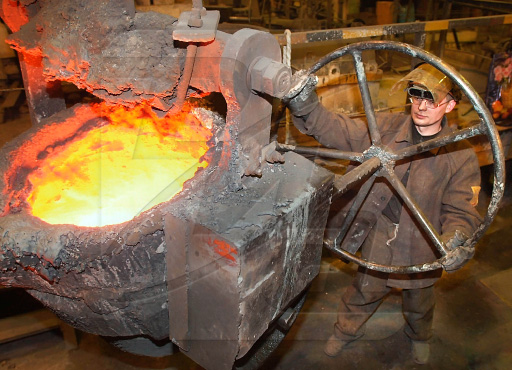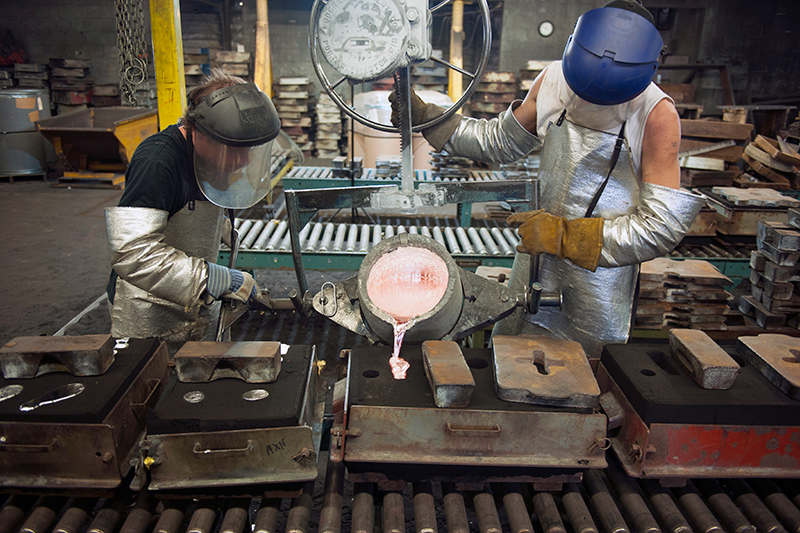A Beginner’s Handbook to Casting Foundry Techniques and Workflows
Wiki Article
Exploring the Vital Role of Casting Foundry in Modern Manufacturing
Casting foundries are pivotal in modern-day manufacturing, supplying vital parts across diverse industries. Casting Foundry. Their capacity to produce intricate, light-weight components meets the expanding needs for efficiency and top quality. The landscape is progressing, influenced by technical improvements and sustainability concerns. As these foundries navigate obstacles and chances, their future role in manufacturing continues to be unsure. What strategies will they utilize to adjust and prosper in this vibrant environment?The Fundamentals of Spreading: Comprehending the Refine
Although Casting has been a basic manufacturing process for centuries, its principles continue to be important to modern-day sector. This procedure involves pouring a fluid product, normally steel, into a mold to develop a specific shape. The mold and mildew is designed to develop the preferred output, which solidifies as it cools down. Trick stages in casting consist of pattern production, mold development, putting, and finishing. Each stage requires cautious interest to information, making sure that the last product fulfills high quality and dimensional standards.The versatility of Casting enables the production of intricate geometries that would be impossible or tough to achieve with other producing approaches. Furthermore, Casting can suit a variety of products, including polymers and steels. This versatility makes it a necessary technique for markets ranging from vehicle to aerospace, supporting technology and efficiency in the production of elements that fulfill the needs of contemporary applications.
Kinds Of Casting Strategies and Their Applications
Casting techniques are diverse, each customized for specific applications and material demands. Sand Casting is just one of the earliest methods, suitable for complex geometries and large parts, using sand molds. Financial investment spreading, known for its accuracy, is excellent for complex layouts and is commonly used in aerospace and medical industries. Die casting, usually used for high-volume manufacturing, enables rapid manufacturing of smaller get rid of great surface finish, usually in light weight aluminum or zinc alloys. Shell Casting provides a balance in between both, providing fine information and excellent toughness, making it preferred in auto applications. Irreversible mold and mildew spreading, utilized for non-ferrous metals, delivers a tighter dimensional resistance and far better mechanical residential or commercial properties. Finally, centrifugal Casting is effective for creating round parts, commonly discovered in tubes and pipes - Casting Foundry. Each technique serves distinct purposes, underscoring the adaptability and relevance of Casting in contemporary productionThe Influence of Casting Foundries on Industry Innovation
As sectors venture for greater performance and product top quality, the function of casting shops ends up being increasingly crucial in driving development. These centers work as the foundation for creating intricate components throughout various markets, including auto, aerospace, and energy. By leveraging sophisticated Casting techniques and materials, factories add to the advancement of lighter, more powerful, and much more sturdy products that satisfy evolving consumer needs.
Furthermore, factories help with the usage of lasting practices, such as reusing metal and minimizing waste, which lines up with modern sector standards for ecological responsibility. Inevitably, the ingenious capacities of casting factories not just enhance making efficiency however also propel whole sectors into a future identified by technological innovation and sustainability.

Difficulties Dealing With Casting Factories in a Modern Economic climate
While advancement continues to reshape the manufacturing landscape, casting foundries encounter a myriad of obstacles that threaten their functional stability. One substantial concern is the boosting competition from advanced manufacturing modern technologies, such as additive production, which can create complex components with much less product waste. In addition, the changing rates of raw products, especially metals, pose economic dangers, affecting cost predictability. Labor scarcities additionally intensify these difficulties, as competent workers come to be harder to retain and discover amidst an aging workforce. Regulatory stress concerning exhausts and work environment safety need shops to invest in pricey upgrades, typically stressing restricted sources. The need for digital makeover also impends huge, as numerous shops battle to adopt Market 4.0 innovations that boost efficiency and information management. Jointly, these difficulties compel casting factories to adjust promptly or risk obsolescence in a significantly competitive market.Sustainability Practices in Casting Foundries
Amidst the difficulties challenging Casting foundries, the adoption of sustainability practices has emerged as a vital strategy for enhancing operational resilience and competitiveness. Foundries are progressively focusing on decreasing waste with effective source administration, reusing scrap steel, and using green products in their procedures. The execution of energy-efficient modern technologies is an additional critical aspect, as it helps lower energy consumption and carbon emissions.Furthermore, lots of factories are taking on closed-loop systems to decrease water usage and reduce the environmental effect of procedures. Employee training in sustainable practices fosters a culture of environmental responsibility, ensuring that all staff member are engaged in sustainability initiatives.
Integrating Technology in Casting Processes
Integrating advanced innovations into casting procedures has come to be an essential consider driving efficiency and technology within factories. Automation and robotics are increasingly used to enhance production, lowering labor prices and lessening human error. Advanced software application for simulation and modeling allows designers to predict end results and optimize layouts before physical manufacturing begins. In addition, the incorporation of 3D printing modern technology considerably enhances the prototyping phase, facilitating quick development and lowering lead times.On top of that, real-time tracking systems making use of IoT gadgets make it possible for factories to track performance metrics and determine prospective issues early in the Casting procedure. This data-driven technique not only improves quality assurance however also supports upkeep methods that avoid pricey downtimes. Because of this, incorporating these technologies cultivates an extra dexterous manufacturing environment, permitting shops to respond rapidly to market needs while keeping high standards of quality and sustainability.
The Future of Casting Foundries in Manufacturing

Furthermore, the need for lightweight and high-performance products in industries like aerospace and auto will drive advancement within shops. Cooperations in between foundries and makers will likely raise, promoting an extra incorporated supply chain that highlights quick prototyping and personalization. As digital change continues, factories might likewise take advantage of information analytics to maximize procedures and forecast upkeep demands, making certain competitiveness. Eventually, the future of casting factories pivots on their capability to adapt to technological improvements and market demands while preserving quality and cost-effectiveness.
Frequently Asked Questions
What Materials Are Typically Used in Casting Foundries?
The products generally made use of in casting shops consist of metals such as aluminum, bronze, steel, and iron, in addition to various alloys. In addition, sand, material, and ceramic are often utilized for molds and core manufacturing.Exactly How Do Casting Shops Guarantee Quality Assurance in Manufacturing?
Casting shops execute rigorous quality assurance measures, consisting of normal evaluations, standardized testing, and adherence to market qualifications. These techniques ensure that each product meets defined resistances and performance standards, therefore keeping high levels of reliability and consumer contentment.What Are the Security Measures in Casting Foundries?
Precaution next page in casting shops consist of the usage of individual safety equipment, proper ventilation systems, regular equipment maintenance, employee training programs, and adherence to safety policies to reduce dangers related to liquified metal handling and machinery operation.
The length of time Does the Casting Refine Commonly Take?
The Casting procedure commonly takes numerous hours to several days, depending on factors such as the complexity of the design, the materials made use of, and the cooling time needed for the actors elements to strengthen effectively.What Is the Function of Designers in Casting Foundries?
Engineers in casting shops look after layout, procedure optimization, and quality assurance. They assure that materials meet specifications, troubleshoot manufacturing concerns, and carry out ingenious techniques, inevitably contributing to performance and the successful manufacture of steel elements.Casting foundries are essential in contemporary manufacturing, giving essential parts across varied visit the site markets. While innovation proceeds to improve the production landscape, casting foundries deal with a myriad of difficulties that intimidate their operational practicality. Among the difficulties confronting Casting factories, the fostering of sustainability techniques has arised as a crucial technique for improving operational durability and competition. In addition, real-time monitoring systems using IoT gadgets allow shops to track performance metrics and determine prospective problems early in the Casting procedure. The products generally used in casting foundries include metals such as aluminum, iron, bronze, and steel, along with numerous alloys.
Report this wiki page